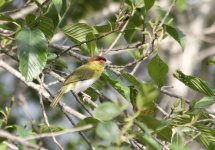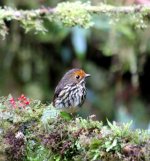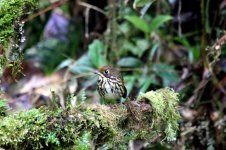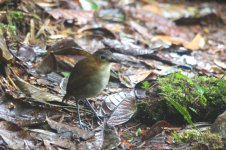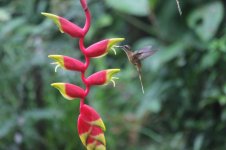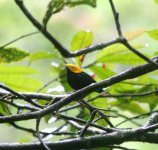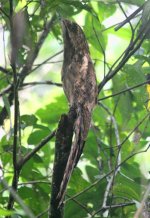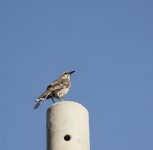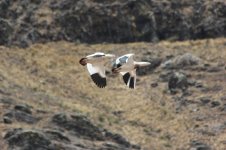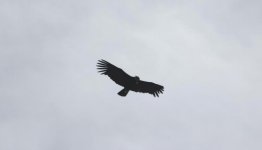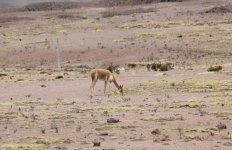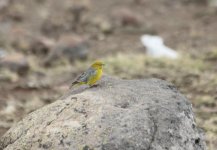Nov 8
This was mostly a travel day, I had signed up for conference-organized transport from the airport to Paracas, and arrived to my hostel in Paracas in the late afternoon. I took a quick stroll along the waterfront with what remained of the daylight, seeing common birds including massive Peruvian Pelicans, numerous Neotropical Cormorants, 5 species of gulls (Franklin's, Grey-hooded, Belcher's, Kelp, and Gray), and shorebirds including American Oystercatcher, Whimbrel, and many Ruddy Turnstones.
Nov 9
I spent most of this day attending a pre-conference workshop at the Hilton/Doubletree, but there is good birding on and around the hotel grounds. A short walk south brings one to the edge of Paracas National Reserve. Beyond the fence were thousands of roosting waterbirds - Black Skimmers and Franklin's Gulls were most numerous, but there were smatterings of other common species. Most notable were the 9 or so Hudsonian Godwits. The pilings behind the hotel also held roosting terns, Royal, Sandwich, and Elegant, with Peruvian Boobies foraging in the background.
Nov 10-11
Conference days - casual birding around the Doubletree, nothing of note except for an Amazilia Hummingbird in downtown Paracas, which I didn't even realize at the time was a lifer! I assumed I had seen it during my previous trip to coastal Peru. I also came down with a nasty cold, though fortunately it didn't hit until after I had given my presentation the first day.
Nov 12
This was a free day and several field trips had been organized as part of the conference. I attended the all-day trip into the Andes along the highway that goes through the village of Huaytara. Our bus left Paracas around 6 am and we arrived at our first stop (highway km 68) at 7:30, in the lower slopes of the Andes, with cactus dotting the mountainsides and scrub lining the river. Here we had Long-tailed Mockingbird, Cinereous Conebill, Amazilia Hummingbird, Blue-and-yellow Tanagers, and a few other common species. Best find here was a pair of Bran-colored Flycatchers, the richly-colored rufescens subspecies that is a probable future split, building a nest in the scrub above the the road.
Our next stop was at km 73, where there was a restaurant and row of shops. The habitat was similar but we added Croaking Ground-Dove, and most people got to see the endemic Black-naped Woodpecker; unfortunately I and a few others only caught a quick, untickable glimpse as it flew off far down the hillside. Drat!!
We pulled over briefly just past km 81 for a large soaring raptor that turned out to be a Black-chested Buzzard-Eagle being harassed by a couple American Kestrels. There were also Andean Swifts overhead.
Our next stop at km 102 was a bit above the coastal desert zone, with thicker scrub vegetation and some eucalyptus that had been planted next to some houses. This was a busy, productive spot, with a real highlight being a group of Andean Parakeets that landed briefly in some roadside trees, allowing everybody a good view before they flew off again. We had great views of Oasis Hummingbird and Purple-collared Woodstar, and a pair of Yellow-billed Tit-Tyrants. There were many of the common species as well such as Blue-and-yellow Tanager, plus a group of Hooded Siskins, the first Chiguanco Thrush of the day, and the only Scrub Blackbird of the trip.
We continued on for quite a while before stopping again, with crisp, cool air greeting us as we got off the bus at 3800 m at the Inkawasi de Huaytara Archaeological Site. There was good bird activity down in the canyon below the dried-up reservoir, with a brief view of Buff-breasted Earthcreepers, Black-billed Shrike-Tyrant, a group of Cream-winged Cinclodes, and just about every sierra-finch-type-thing possible: Peruvian, Mourning, Ash-breasted, and Plumbeous Sierra-Finch, plus a flyby Greenish Yellow-Finch. The reservoir was mostly mud but nonetheless contained a big group of Yellow-billed Teal, and a pair of Andean Geese flew in and gave us all great views. We walked down a dirt road past some fenced pastures and buildings, adding Andean Flicker, White-fronted and Rufous-naped Ground-Tyrants. A shout of "Condor!!" got everyone's attention, and we were treated to fairly close views of a male Andean Condor soaring past us. Also up in the sky were Mountain Caracara and Variable Hawk.
We continued ever higher, reaching up into the wide expanse of the Puna and spotting many Vicuna (wild ancestor of the Alpaca) from the bus, and stopping for one group next to the road. We made two more stops to walk out into the puna, one stop netting Common Miner and the endemic Dark-winged Miner, Aplomado Falcon, and Bright-rumped Yellow-Finch; the last stop at a wet area with Crested Ducks. We turned around at 3 pm for the 3 or so hours of driving back to Paracas; it had been a great day of birding and the drive was scenic, although descending from ~4500 m to sea level was hell on my badly congested sinuses and ears, it took a while before I could properly hear again!





